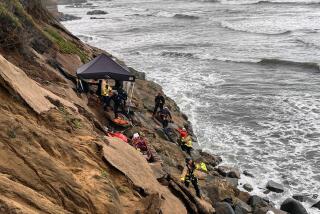Spelunkers Dig Caving Deep Down : Exploration: To Vermont’s small band of cavers, the caverns burrowed into the limestone comprise a beautiful and fragile underworld. Hypothermia is a primary risk.
- Share via
WEYBRIDGE, Vt. — Compared with the expansive caves of the South and West, Vermont’s 45 known caves are small and a bit dingy. The glaciers that once covered the region filled the caves with mud and rock.
But, to the state’s small band of active cavers, the caves burrowed into the limestone comprise a beautiful and fragile underworld. To see that world, cavers, or spelunkers, crawl through muck and over boulders and squeeze themselves through small passages. It’s a claustrophobic’s nightmare.
In a cave near Middlebury College, for example, cavers enter through a crack in the rock several feet wide and squeeze themselves about 20 feet over ice or running water, depending on the season. Getting wet is unavoidable.
From there, cavers rappel 20 feet to a rock landing, then rappel another 50 feet to the cave floor. All of this is done in the dark with the aid of a miner’s helmet and light. The interior is humid and musty; dripping water is the only sound.
Aside from the danger of falling, hypothermia is the primary risk in Vermont’s caves because cavers sometimes must wade or swim through underground streams.
“Caving isn’t super-popular in the Northeast because it’s cold,” said Kevin O’Classen, vice president of the Vermont Cavers Assn. The temperature in a cave remains unchanged year-round; in Vermont, it’s about 45 degrees.
The Middlebury cave reaches depths of nearly 150 feet. Its largest room is about 30 feet wide and 30 feet high. In spring the cave fills with water, evidenced by leaves stuck to the ceiling.
Smaller passages shoot to the sides and require cavers to shimmy on their stomachs across mud. Sometimes cavers can’t turn around until they reach another room.
Without lights, cavers are in complete darkness, and no amount of time allows the eyes to adjust. Ordinary sounds such as breathing become magnified because the stone walls muffle all outside noises.
Caving evokes strange emotions and requires a beginner to squelch feelings of panic. The Vermont Cavers Assn. frowns on beginners entering alone or without training. “Safety and conservation are our general concerns,” O’Classen said.
O’Classen carries battery packs that power his helmet light for 100 hours. He prides himself on being able to tie climbing knots behind his back and in the dark.
Cavers have varied reasons for coming to the sport, but all feel a responsibility for protecting the fragile rock formations and cave wildlife such as bats.
Ron Miller became an active caver in college after being exposed to the sport as a child. His parents went caving on their honeymoon.
The highlight of his caving experiences came in 1992 on a trip to Belize, when he and several other explorers discovered an underground Mayan site littered with hundreds of pieces of pottery and pottery fragments.
“There was a sense of awe that we were the first humans to tread the same path that these people had established roughly a thousand years earlier,” Miller said.
The crew emerged in the jungle 15 hours after entering.
Although Vermont has nothing to match the magnitude of that cave, the state does have the essential component of caves: limestone. The soft rock is eaten away over the ages by running water.
New Hampshire’s bedrock is primarily granite; it has only talus caves, formed by falling rock and boulders. Maine has patches of limestone and some small caves.
In the United States, Virginia, West Virginia, Tennessee and Alabama are known for their lengthy caves. New Mexico and areas of the West also have expansive ones.
David Luckins, president of the National Speleological Society in Huntsville, Ala., says the group has 250 chapters nationwide.
The 52-year-old society, based in Huntsville, has 12,000 members worldwide. Its headquarters is in a former church--on land with a cave.
The society is sending an expedition to China this year to explore some water-filled caves. Part of the mission will be to train the Chinese in advanced underwater caving, Luckins said.
More to Read
Sign up for The Wild
We’ll help you find the best places to hike, bike and run, as well as the perfect silent spots for meditation and yoga.
You may occasionally receive promotional content from the Los Angeles Times.






